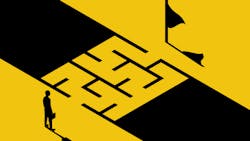“I was burned-out in my practice, working so hard, and felt like I wasn’t being the leader I needed to be,” says Hiru Mathur, DDS, a periodontist from Sugar Land, Texas. “As a practice owner, you’re so isolated, and then you just get lost in your own stress.”
Dr. Mathur is not alone. This is a common story among the hundreds of dentists I’ve worked with. After achieving great success in her dental career, Dora Lee, DDS, a pediatric dentist in Los Alamitos, California, felt the same way: “The doctor part is becoming slowly less and less important in my life.”
For years, you focus on developing your clinical skill set and getting your dental license, followed by years of building your dental practice. You work hard to create a business that is dependent on your direct involvement and daily practice of dentistry. You are “irreplaceable,” and this feels good.
As business grows, you continue to double down on your investment of time and effort. After all, the buck stops with you, and more revenue means greater success. You end up doing it all—from providing direct services and managing employees to dealing with accounting and custodial issues.
Then, the drudgery and monotony of solving the same problems lead to burnout and frustration. Your life becomes a daily grind with no end in sight. While working this way allows a certain lifestyle for your family, it comes at great cost. This may be why the average retirement age of dentists is 69—seven years longer than the average of 62.1
Time for a change
When you trade your time for money, this is “transactional” or active income. It’s what the educational system teaches us. This creates workers who produce the goods and services others purchase, and this division of labor is a highly efficient model.
The other side of this societal norm is that we are all supposed to take part in “retirement planning” for when we can no longer work. Since the creation of the 401(k) in 1978, responsibility for retirement planning shifted from large companies (pension plans were a fiscally unsustainable model) to the individual (today’s retirement accounts). You are supposed to save money acquired from your labor and invest it through various Wall Street financial vehicles and tax-deferred plans. An entire industry of “wealth advisors” with accompanying financial products has grown to profit from this model.
More about retirement planning ... Less work, more joy: Your retirement should start now
The whole process centers around stockpiling enough money to live on when you retire. The assumption is that you will spend the best years of your life maximizing your production (saving as much as you can) and be taken out of service when you are no longer able to contribute at a high level. Society has conditioned us to measure success within the confines of this model.
Few ever stop to question this construct or ask: What if there were an alternative path to a better life for me and those I care for?
I didn’t ever consider such a possibility until I got my wake-up call when my 11-year-old daughter had to fight for her life against leukemia. Until that time, I had spent years focusing on building more income and net worth. I had no idea how much was enough; I just knew I needed to produce more. Without realizing it, my family, health, and ability to be a “good and empathic person” suffered. It was all about my goals.
But then, I realized I needed to be there for my daughter. She was the priority.
The deception is that “someday,” when we have “enough,” we will turn the tide, create new habits, begin to enjoy life, and become a better person. But know that change does not happen without a definitive plan. Don’t wait for a traumatic life event to make you open your eyes and realize what is really going on like I did.
Time to play by different rules
In my recent book,2 one of the principles of freedom is that “wealth is what you own, not what you do.” The mindset shift from transactional (active) income to asset-produced (passive) income is the most significant fulcrum in creating financial independence, and it’s the base of the Five Freedoms.3
Like Abraham Maslow’s Hierarchy of Needs, my Five Freedoms model focuses on the ascension to financial independence via time freedom, relationship freedom, health, purpose, and meaning. In this concept, the ascension is not linear but concurrent. Time is the great differentiator. Time is valued from the beginning, instead of suppressed to some mystical future date.
Your ticket to freedom: Creating a financial plan B
Without creating a plan B for passive income, a higher-than-average income only serves to elevate one’s lifestyle while digging deeper into the ever-running hamster wheel of transactional income. We disregard time for some undefined future. I call this “the curse of the high-income earner.” Once you realize this, you can take appropriate action to switch from a focus on lifestyle to a focus on freedom.
This is what happened with Dr. Lee. Her mindset shifted, and she realized she didn’t need to continue in the traditional cycle of a long day-to-day grind behind the dental chair until a distant retirement date. She took control and created a portfolio that gave her a steady stable income independent of her dental practice, while avoiding economic stress and pressure.
More about retirement planning ... How to keep inflation from destroying your future
Dr. Lee says, “I never thought that I could work one day a week in my practice and let it run for five days, and now I can. Having that choice is just a freeing sense of mind; I don’t have these golden handcuffs chaining me to the practice anymore.”
Now, she spends her time traveling, learning about people and other cultures, and documenting her experiences through photography. “Doing all this traveling and seeing countries that are still developing really helped me see what global health looks like, and so at some point, that’s my ultimate goal or vision in life. I’m glad I didn’t wait until I was about to retire to start thinking about what I’m going to do with the rest of my life.”
Similarly, Dr. Mathur knew there was more to life than the “someday” of traditional retirement. “You see all these great people doing these amazing things, how they’re leading their practices, how they are growing, and you know change is possible.”
At that point, she got the information she needed to reallocate her investment portfolio into cash-flow-producing investments. When she accomplished her goal of having passive cash flow producing more than her active income, she found that she still enjoyed her practice, but now she’s changed her model to rely less on her production as a clinician. This gives her more freedom from the dental chair and choices for how she spends her time.
Avoid burnout and move to what’s next
When you replace active income (trading time for dollars) with passive income and cash-flow-producing assets, you have more freedom of time and space to be creative and think bigger. You can then experiment with a different model that you love. Rather than retire, you evolve … just like Dr. Mathur and Dr. Lee did. Dr. Mathur is now solving more complex problems and creating a bigger impact in the world, and Dr. Lee is pursuing her love of photography and travel rather than waiting on that retirement date in the future.
The rules of the game are changing. You can continue to stick with the status quo, work longer and harder while focusing on increased production and efficiency, saving away for a distant retirement date. Or, you can think differently and create a plan with measurable milestones that will lead you to true financial freedom sooner rather than later. It’s up to you. Will you step on the new path to discover improved relationships, health, and, ultimately, your purpose and meaning in life?
Editor's note: This article appeared in the October 2023 print edition of Dental Economics magazine. Dentists in North America are eligible for a complimentary print subscription. Sign up here.
References
- Bateman A. 5 reasons dentists retire 7 years later than the average American (and how to fix that). Dental Economics. January 7, 2022. https://www.dentaleconomics.com/money/article/14214867/why-dentists-retire-7-years-later-than-the-average-american-and-how-to-fix-that
- Phelps D, Kennedy DS. Own Your Freedom: Sustainable Wealth for a Volatile World. Conversation Publishing; 2021.
- Phelps D. Do you need a financial transformation for your retirement planning? Dental Economics. July 5, 2023. https://www.dentaleconomics.com/money/article/14294767/do-you-need-a-financial-transformation-for-your-retirement-planning
About the Author

David Phelps, DDS
David Phelps, DDS, founder of Freedom Founders, was able to turn to his alternative investments, step away from his dental practice, and be by the side of his young daughter when she was hospitalized with leukemia. He created the Freedom Founders community in 2012 to help dentists and other professionals take control of their retirement investments to produce passive cash flow, security, and live life on their terms. To contact Dr. Phelps, visit freedomfounders.com.
